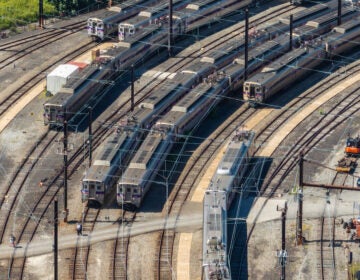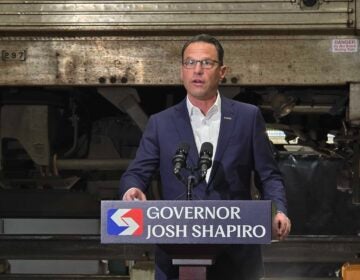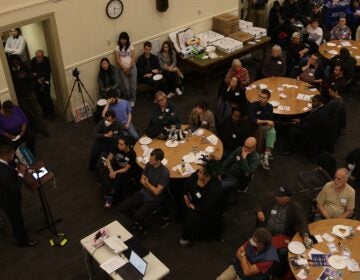Get your kicks on Route 66: Philly’s first line with transit signal prioritization also under consideration for stop consolidations

As SEPTA’s popular Route 66 trackless trolley runs up and down its six-mile stretch of Frankford Avenue, it stops dozens of times. At some points, the stops are less than 300 feet apart – the length of a football field.
But the Transit First Committee wants to change that, proposing thirteen stop consolidations and another eight stop relocations, all designed to speed up the Route 66 trackless trolleys, or trolleybuses.
The Transit First Committee is a combined effort of SEPTA, the Streets Department, the Mayor’s Office of Transportation and Utilities, and the Delaware Valley Regional Planning Commission; it’s like the Captain Planet of transit improvement planning, if Captain Planet’s super power was marginally reducing transit headways.
The Committee has already installed transit signal priority technology along Route 66, giving the trolleybuses the sort of traffic light prioritization that emergency vehicles get, thereby improving on-time performance by four percent.
Route 66 is the first transit signal prioritization in the city, according to SEPTA spokesman Manny Smith. But it isn’t the last: another five routes have had transit signal prioritization hardware installed and are now working out the kinks before going online: Route 58 on Bustleton Avenue, Route 6 on Ogontz Avenue, Route 60 on Allegheny Avenue, Route 52 (befittingly) on 52nd Street, and the Route 11 trolley on Woodland Avenue.
While it might not make for a great Saturday morning cartoon, the Committee makes projects like this one possible, by reducing the political flak any one agency has to take.
WAIT, TROLLEYBUS? WHAT THE HECK IS A TROLLEYBUS?
Unfortunately, a “trolleybus” isn’t a transformer out of a transit nerd’s dreams, rotating out diesel-powered rubber wheels for stainless steel and electric wires the second tracks appear. Rather, a trolleybus is what it sounds like: basically, a regular bus powered by overhead electrical wires, like a trolley. Unlike that first thing, real trolleybuses are relatively efficient hybrids particularly useful on hilly routes that run rather quietly.
But trolleybuses also share some of the less desirable qualities of buses and trolleys. Like trolleys, they have trouble detouring around obstacles and require wires that some consider unsightly. Aesthetically, they look like buses, which carries a stigma with some riders.
SEPTA is one of the few transit authorities in the U.S. that still operates trolleybuses. In addition to the 66, Routes 59 and 75 are also trackless trolleys. Both operate in Northeast Philadelphia. And if this isn’t enough trolleybus trivia for you, SEPTA has a fairly lengthy history of its fleet to check out.
GET RID OF BUS STOPS? INCONSOLIDATEABLE!
This isn’t the first time the Transit First Committee attempted to consolidate some bus stops. PlanPhilly recently wrote about that first attempt – consolidation on South Philly’s Route 47 – in one of our Streetsplainers.
That attempt in 2011 ultimately didn’t pan out – some speed gains on the northbound route were wiped out by delays on the southbound and the overall effect was not a whole lot. The culprit there: stop signs. Bus stop consolidation’s biggest time improvements come from reducing the amount of time buses spent speeding up and slowing down, not picking up and dropping off passengers (who’ll relocate to the nearest stop and take about the same amount of time to get on and off). The Transit First Committee learned that if the bus has to stop at a sign anyway, there’s little point in consolidation.
Which is why the Committee is now looking to get its consolidation kicks on Route 66. Route 66 is the 23rd busiest route of 83 city transit lines, with an average of 10,359 daily riders in 2014. Instead of an endless march of stop signs, Frankford Avenue has a bunch of intersections with traffic lights.
Since transit signal prioritization went live along the route, on time performance increased 4 percent, up from 87 percent in 2014. “On time” is a term of art in the transit industry, meaning vehicles come and go within six minutes of the scheduled time, but that’s still a significant improvement. The Committee hopes to leverage the transit signal prioritization gains by getting rid of a few unnecessary – and sometimes dangerous – stops.
“There are a lot of stops that are in un-signalized locations,” said Dan Nemiroff, a senior operations planner at SEPTA. Those stops at side streets between two larger intersections encourage riders to cross Frankford Avenue mid-street, rather than in safer locations with light signals and cross walks.
In addition to consolidating thirteen stops, the Committee proposes relocating eight others to the far side of intersections – stopping after, rather than before, the intersection. In certain contexts, this can also speed up buses and trolleys that might otherwise need to wait at a just-changed light after picking up passengers.
The Committee knows this will be a hard sell for regular riders. It always is with stop consolidation, admits Nemiroff. Often, seniors and others with mobility issues complain about the longer walks consolidation can cause them.
“We’re assuming we’ll get some pushback about various locations,” Nemiroff says.
“But we don’t know which ones those are.”
That’s why the Committee has been reaching out to the public and soliciting feedback from riders. You can look at a full list of the proposed stops for consolidation and relocation, and submit feedback here.
WHYY is your source for fact-based, in-depth journalism and information. As a nonprofit organization, we rely on financial support from readers like you. Please give today.






